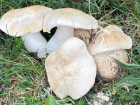Cap white-creamy coloured to bright yellow, often with a brownish tinge. At first sub-spherical, becoming expanded and irregularly convex with an incurved margin. Gills sinuate, white and very crowded. The flesh is thick and soft and has a mealy or cucumber smell. Stem whitish, smooth, bulky at the base. There is no stem ring. Spore print white to pinkish white.
Microscopic Features: The spores are ellipsoidal and smooth, measuring 5-6 x 3-4µm.
Calocybe gambosa on the www.first-nature.com web site.
Many mushrooms are poisonous, and some can be lethally toxic. Distinguishing between edible and poisonous mushrooms can be very challenging. Therefore, we strongly advise against consuming wild mushrooms. This website does not contain any information about the edibility or toxicity of mushrooms.
Although efforts have been made to ensure accuracy on this website, the information may contain errors and omissions. Therefore, all content provided is for educational and informational purposes only and should not be relied upon or used as a basis for consuming any plants or mushrooms.
External links are provided for reference only. We do not endorse or take responsibility for the content, advice, or products found on these sites or in any advertisements shown on this website.
